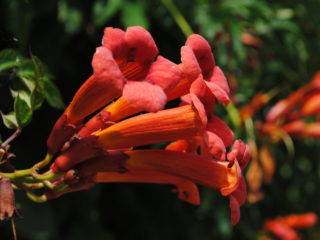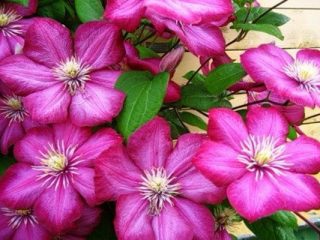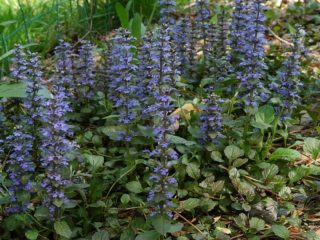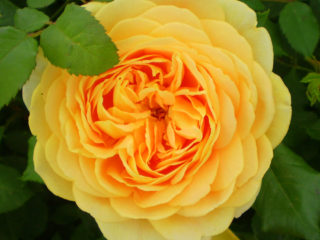Content
Parks and squares of southern cities are decorated with hedges made of climbing plants. This is Campsis grandiflora - a species of woody deciduous vines of the Begoniaceae family. High decorative properties and unpretentiousness have made Kampsis an indispensable assistant for landscape designers who use the plant to enliven landscapes.
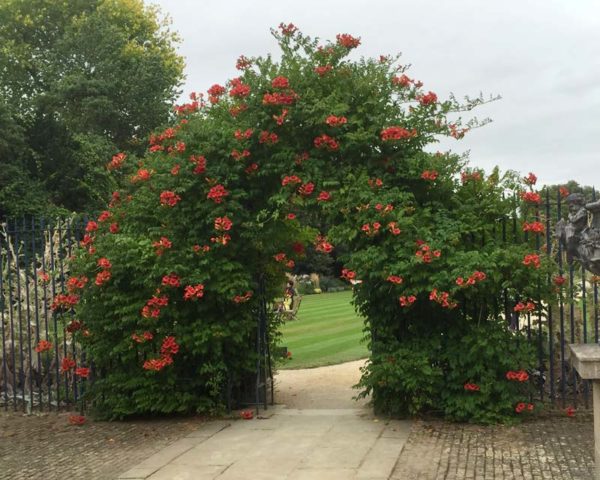
Campsis grandiflora is often used to decorate arches and verandas in southern parks and squares.
Description of large-flowered campsis
Campsis grandiflora is a perennial climbing plant with a flexible, woody trunk. He is one of the aggressors whose growth must be organized and directed. Otherwise, the campsis actively grows, filling the free space, preventing the development of trees and bushes close to it.
Campsis has two natural species. Campsis grandiflora (native to China and Japan) is very decorative due to its large and beautiful flowers.And the rooting campsis (natural habitat is North America) is tenacious and frost-resistant, which made it possible to breed it in regions with a more severe climate.
The flowering period of Campsis grandiflora is long: the first buds appear in the second half of June. Flowering lasts all summer, until mid-September. The flowers are much larger than those of Kampsis rooting (they are up to 8 cm in diameter), collected in paniculate inflorescences (7-9 flowers in each).
The trunk of the plant, green at the beginning of life, becomes woody as it matures, acquiring a brown tint. The shoots are of medium length (in its rooting counterpart they are more elongated). In this regard, Campsis grandiflora is a bush-like form and does not exceed 10 meters in height. It grows extremely quickly, young shoots braid the support, climbing up it in a spiral.
The dark green foliage of begonia vines is also decorative. Compound leaves have from 7 to 9 small glossy plates, unpaired on a common petiole (rachis).
In autumn, the period of fruiting of Campsis grandiflora begins. At this time, in place of the fallen inflorescences, numerous fruits are formed in the form of oblong pods.
The best varieties
Campsis has always attracted the attention of breeders. Attempts have been made to develop various hybrid forms and varieties that combine the best breed properties of mother plants.The most successful hybrids bred on the basis of Campsis grandiflora are “Campsis Thunberg” and “Campsis Morning Freshness”.
Campsis Thunberg
Campsis Thunberg was named after the Swedish naturalist scientist Carl Peter Thunberg. It first began to be cultivated at the beginning of the 19th century. The variety is distinguished by bright orange flowers with a shortened tube. The plant is suitable for cultivation in areas with colder climates.
Morning Freshness
The variety Morning Freshness has an external resemblance to Kampsis Thunberg, but its flowers are more decorative. They are bright orange with a yellow base. The petals are decorated with reddish veins.
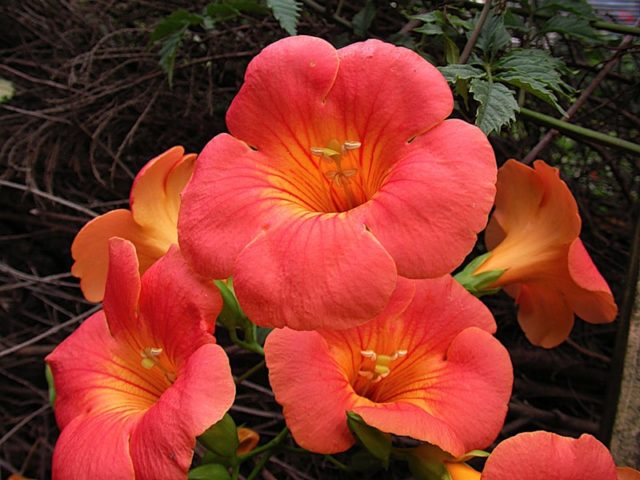
The variety Morning Freshness, bred on the basis of Kampsis grandiflora, is beautiful with its elegant flowers
Application in landscape design
Campsis grandiflora is characterized by rapid growth. Creeping stems, within a short time, weave all available surfaces, protecting and decorating them. By allowing the vine to grow freely along vertical supports, you can add greenery to a garden fence, arch or house wall. The plant will mark the boundaries of a personal plot or divide the territory into separate economic zones.
A gazebo or veranda, densely intertwined with shoots, looks very picturesque. This way you can decorate any recreation area with a plant. When handled skillfully, Campsis grandiflora can be perfectly combined with garden furniture or small architectural structures.
Experienced designers guide the shoots of the plant, forcing it to twine around the vertical support in such a way that the large-flowered campsis forms into a beautiful, neat tree or shrub with a lush crown.
Reproduction methods
Campsis grandiflora, like all vines, is very viable.Therefore, both generative (seed) and vegetative (shoots, layering and cuttings) methods are suitable for plant propagation.
Seeds
The seed method of propagating Campsis grandiflora is used less frequently than others, since it has a number of significant disadvantages:
- When seed propagation of hybrid varieties occurs, there is a risk of losing the valuable properties of the parent plants.
- Plants obtained by seed do not bloom for a long period of time (5-7 years after planting).
Campsis grandiflora seeds collected for planting in the fall do not lose their properties for a long time. Seeds are sown for seedlings in early spring. To do this, first prepare a nutritious soil mixture with a neutral composition, and then scatter it into containers. The seeds are sown, deepening them by approximately 0.5 cm and watered abundantly.
To germinate, place the container with Campsis grandiflora seeds in a warm place and cover the top with plastic wrap. In about a month, the first shoots should appear. When 3-4 pairs of true leaves are formed, the seedlings are transplanted to a permanent place. Young plants are accepted well and are actively developing.
Basal shoots
This method is used in early spring or autumn. A powerful root shoot is selected and dug out along with part of the root, after which it is transplanted to a permanent place, watering abundantly. The plant usually takes root well.
By layering
A cutting is a rooted above-ground shoot belonging to the mother plant. They are grown using the lowest branches of Campsis grandiflora. Having chosen the most powerful one, bend it to the ground, carefully sprinkle it and fix it in this position, waiting for rooting. Water and care for the same as the mother plant. The following spring, the established sprout is separated from the mother branch, carefully dug up and planted in a permanent place.
Cuttings
This method is only applicable in summer. The cuttings are prepared and planted in the ground in June or July, since the plant must have time to take root before the onset of frost. Cut off strong stems, leaving the middle part with the upper leaves. The prepared cuttings are planted in improvised beds at a slight angle. Caring for cuttings involves regular watering and mulching. After rooting, young plants are dug up for planting in a permanent place.
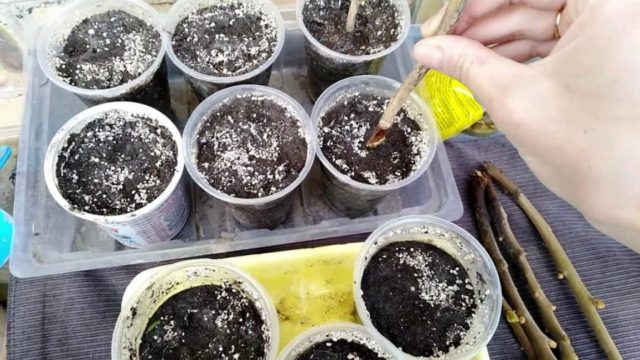
It is convenient to propagate Kampsis grandiflora from cuttings in small plastic containers
Planting and care
Campsis grandiflora is extremely unpretentious - both planting and caring for it are simple. Even an inexperienced and novice gardener can grow it on his own plot.
Recommended timing
Large-flowered campsis is quite thermophilic, so it is recommended to plant it in permanent soil in April-May. At this time, as a rule, the earth is already sufficiently warmed up, and the risk of spring frosts is minimal.In the south, this can be done from mid-April, and in colder climates - no earlier than mid-May.
Site selection and preparation
For planting Campsis grandiflora, choose the southern or southeastern part of the site - the one where there is more sun and no drafts. It is also necessary to ensure that there are no other plants in the immediate environment, since the climbing vine can destroy them. The plant is unpretentious to the composition of the soil, but it is important to ensure that it is always sufficiently loosened and moistened. Good flowering can be achieved on soils saturated with essential microelements.
In autumn, planting holes (about 30 by 30 cm) are prepared for the plant. If the soil is clayey, then drainage in the form of pebbles or broken bricks is laid at the bottom. Then, the excavated soil is mixed with humus, sand and complex mineral fertilizer and, temporarily covering the holes, left until spring.
Landing algorithm
In the spring, when the growing season begins, planting begins. Having filled the hole approximately halfway, place the seedling, carefully straightening the roots. After pouring out the remaining soil, compact it. After this, water it abundantly and sprinkle the tree trunk circle with mulch. Each sprout must be provided with a vertical rail along which it will climb as it grows.
Watering and fertilizing schedule
After planting, Campsis grandiflora needs regular watering. With the onset of heat, irrigation should be daily. They are carried out in the morning or evening, when sun activity is minimal. At the end, the soil is mulched, preventing moisture evaporation.
Trimming and shaping
Pruning and crown shaping are important care procedures for Campsis grandiflora. They are necessary in order to prevent rapid expansion in width, which can choke the growth of other garden plantings. By removing old, outdated branches of the plant, a lush color is achieved, since the development of new buds occurs on young shoots.
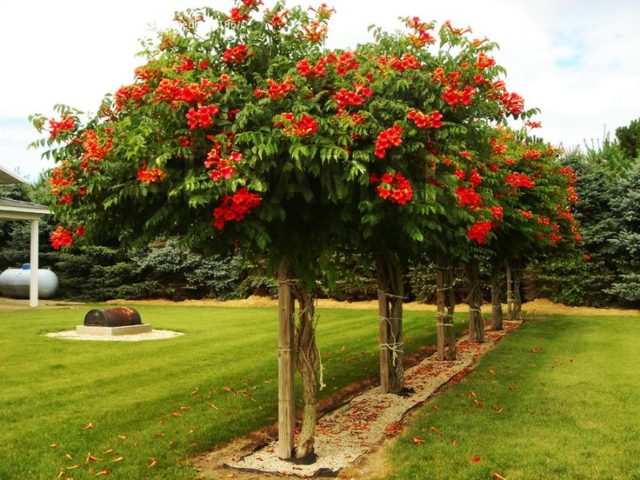
The formation of the crown of Campsis grandiflora allows you to imagine the plant in the form of an unusual tree
Caring for the future crown begins immediately after planting young seedlings of Campsis grandiflora in the ground. Pruning is done immediately, leaving a part of the stem above the ground not exceeding 20 cm. Further development of the plant is controlled by removing some shoots and leaving only the most powerful ones. They are secured to a support, giving them the desired direction of growth.
In order to ensure sufficient crown density, side shoots are pruned. This will stimulate lush branching. Pruning and shaping is done in early spring, before the tree sap awakens. At the same time, sanitary pruning is carried out, branches broken off and damaged during the winter are removed. To help the formation of new buds, faded flowers and leaves are torn off.
Preparing for winter
Campsis grandiflora does not have good frost resistance, so it requires mandatory pre-winter preparation. First, damaged branches and wilted shoots are removed. The tree trunk circle is cleared of fallen leaves, since in the spring they can become a source of proliferation of fungal infections.
The roots are sprinkled with sand, and the plant itself is carefully removed from the support, laid on the ground and wrapped in spruce leaves or wood shavings. In the event that it is not possible to remove Campsis grandiflora from the supports, the covering material is placed vertically, fixing it on the branches. The top leaves of the plant are covered with polyethylene.
Pests and diseases
Campsis grandiflora is a genetically healthy crop. Possible diseases can be caused by poor care (lack or excess of mineral fertilizers, too much watering) as well as unfavorable climatic conditions (too rainy or dry summers). The most common diseases are:
- Bacterial rot is caused by pathogenic bacteria of the genus Pectobacterium and Erwinia. It can be provoked by an excessive amount of fertilizer, waterlogging of the roots with stagnant water, or unsuitable soil. The infection penetrates through mechanical damage to the leaves. The main preventive measures are disinfection of the soil before planting, treatment of plant cuts and garden tools with an antiseptic.
- Fungal plant diseases are provoked by a damp, cool climate. The fungus appears as brown spots on the leaves. To prevent its development, large-flowered campsis should be planted only on the sunny side, and organic residues should be removed in preparation for winter. The main therapy for fungus is treatment with a fungicide (mainly Bordeaux mixture).
- A viral infection of Campsis grandiflora is indicated by a long absence of flowering and fruiting, and a yellow coating on the leaves. For protection, diseased areas are removed. If large areas are affected, the plant is eliminated entirely.
- When it gets hot, the leaves of large-flowered campsis can be affected by aphids. They fight it by spraying the plantings with a solution of ammonia (50 ml per 4 liters of water).
Conclusion
Campsis grandiflora is a rather aggressive crop. Having decided to use vines on your site, you need to remember about precautions, planting and caring for the plant.
